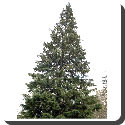 Hemlock — Tsuga is a genus of conifers in the family Pinaceae. The common name hemlock is derived from a perceived similarity in the smell of the crushed foliage to that of the unrelated herb poison hemlock; see hemlock for other senses of the word. Unlike the herb, the species of Tsuga are not poisonous. There are between eight and ten species within the genus depending on the authority, with four occurring in North America and four to six in eastern Asia.
Hemlock — Tsuga is a genus of conifers in the family Pinaceae. The common name hemlock is derived from a perceived similarity in the smell of the crushed foliage to that of the unrelated herb poison hemlock; see hemlock for other senses of the word. Unlike the herb, the species of Tsuga are not poisonous. There are between eight and ten species within the genus depending on the authority, with four occurring in North America and four to six in eastern Asia.
They are medium-sized to large evergreen trees, ranging from 20–60(–79) m tall, with a conical to irregular crown, with the latter occurring especially in some of the Asian species. The leading shoots generally droop. The bark is scaly and commonly deeply furrowed, with the colour ranging from grey to brown. The branches stem horizontally from the trunk and are usually arranged in flattened sprays that bend downward towards their tips. Short spur shoots, which are present in many gymnosperms, are weakly to moderately developed. The young twigs as well as the distal portions of stem are flexible and often pendent. The stems are rough due to pulvini that persist after the leaves fall. The winter buds are ovoid or globose, usually rounded at the apex and not resinous. The leaves are flattened to slightly angular and range from 5–35 mm long and 1–3 mm broad. They are borne singly and are arranged spirally on the stem; the leaf bases are twisted so the leaves lie flat either side of the stem or more rarely radially. Towards the base the leaves narrow abruptly to a petiole set on a forward-angled, pulvinus. The petiole is twisted at the base so that it is almost parallel with the stem. The leaf apex is either notched, rounded, or acute. The undersides have two white stomatal bands (in T. mertensiana they are inconspicuous) separated by an elevated midvein. The upper surface of the leaves lack stomata, except in T. mertensiana. They have one resin canal that is present beneath the single vascular bundle.
The wood obtained from hemlocks is important in the timber industry, especially for use as wood pulp. Many species are utilised in horticulture, and numerous cultivars have been selected for use in gardens.
 Kids Portal For Parents India Kids Network
Kids Portal For Parents India Kids Network






